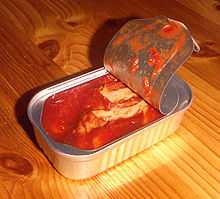Atlantic mackerel
| Atlantic Mackerel | |
|---|---|
 | |
| Scientific classification | |
| Kingdom: | Animalia |
| Phylum: | Chordata |
| Class: | Actinopterygii |
| Order: | Perciformes |
| Family: | Scombridae |
| Tribe: | Scombrini |
| Genus: | Scomber |
| Species: | S. scombrus |
| Binomial name | |
| Scomber scombrus Linnaeus, 1758 | |
The Atlantic mackerel (Scomber scombrus), is a pelagic schooling species of mackerel found on both sides of the North Atlantic Ocean. The species is also called Boston mackerel, or just mackerel.
The Atlantic Mackerel is by far the most common of the ten species of the family that are caught in British waters. It is extremely common in huge shoals migrating towards the coast to feed on small fish and prawns during the summer.
Abundant in cold and temperate shelf areas, it forms large schools near the surface. They overwinter in deeper waters but move closer to shore in spring when water temperatures range between 11–14 °C (52–57 °F).
In north-east Atlantic: North Sea (east) and British Isles (west). The North Sea stock decreased dramatically in the 1960s because of direct overfishing.
Male and female Atlantic mackerel grow at about the same rate, reaching a maximum age of about 20 years and a maximum fork length of about 47 centimetres (19 in). Most Atlantic mackerel are sexually mature by the age of three years.
Fisheries

As food
| Nutritional value per 100 g (3.5 oz) | |
|---|---|
| Energy | 858 kJ (205 kcal) |
| Carbohydrates | 0 g |
| Fat | 14 g |
| Protein | 19 g |
| Water | 64 g |
| Vitamin A equiv. | 50 μg (6%) |
| Choline | 65 mg (13%) |
| Vitamin D | 643 IU (107%) |
| Calcium | 12 mg (1%) |
| Iron | 1.63 mg (13%) |
| Magnesium | 76 mg (21%) |
| Phosphorus | 217 mg (31%) |
| Potassium | 314 mg (7%) |
| Zinc | 0.63 mg (7%) |
| Percentages are roughly approximated using US recommendations for adults. Source: USDA Nutrient Database | |
Atlantic mackerel are sought after for food either cooked or as sashimi. It consists mostly of red meat and has a strong taste desirable to some consumers. Atlantic mackerel is extremely high in vitamin B12. Atlantic mackerel is also very high in omega 3 (a class of fatty acids), containing nearly twice as much per unit weight as does salmon. Unlike King mackerel and Spanish mackerel, Northern Atlantic mackerel are very low in mercury, and can be eaten at least twice a week according to EPA guidelines.[1][2]
Mainly in Scandinavia and the United Kingdom, canned mackerel in tomato sauce, brine, or vegetable oil, is sometimes eaten with salad or in sandwiches.
Mackerel is an excellent source of Phosphatidylserine as it contains approximately 480 mg / 100 grams by weight. Phosphatidylserine is under investigation to mitigate symptoms of ADHD and Alzheimer's disease.
-

A smoked Atlantic mackerel
-

Mackerel fillet in tomato sauce, a popular food in Scandinavia, Finland, Poland and the UK
Notes
References
- "Scomber scombrus". Integrated Taxonomic Information System. Retrieved 18 April 2006.
- Froese, Rainer and Pauly, Daniel, eds. (2006). "Scomber scombrus" in FishBase. January 2006 version.
- Atlantic mackerel NOAA FishWatch. Retrieved 11 November 2012.
External links
- gma.org - atlantic mackerel information
- Blue Ocean Institute - Atlantic Mackerel fishing and conservation report
- EDF Report on Mackerel - Atlantic Mackerel conservation and contamination report

